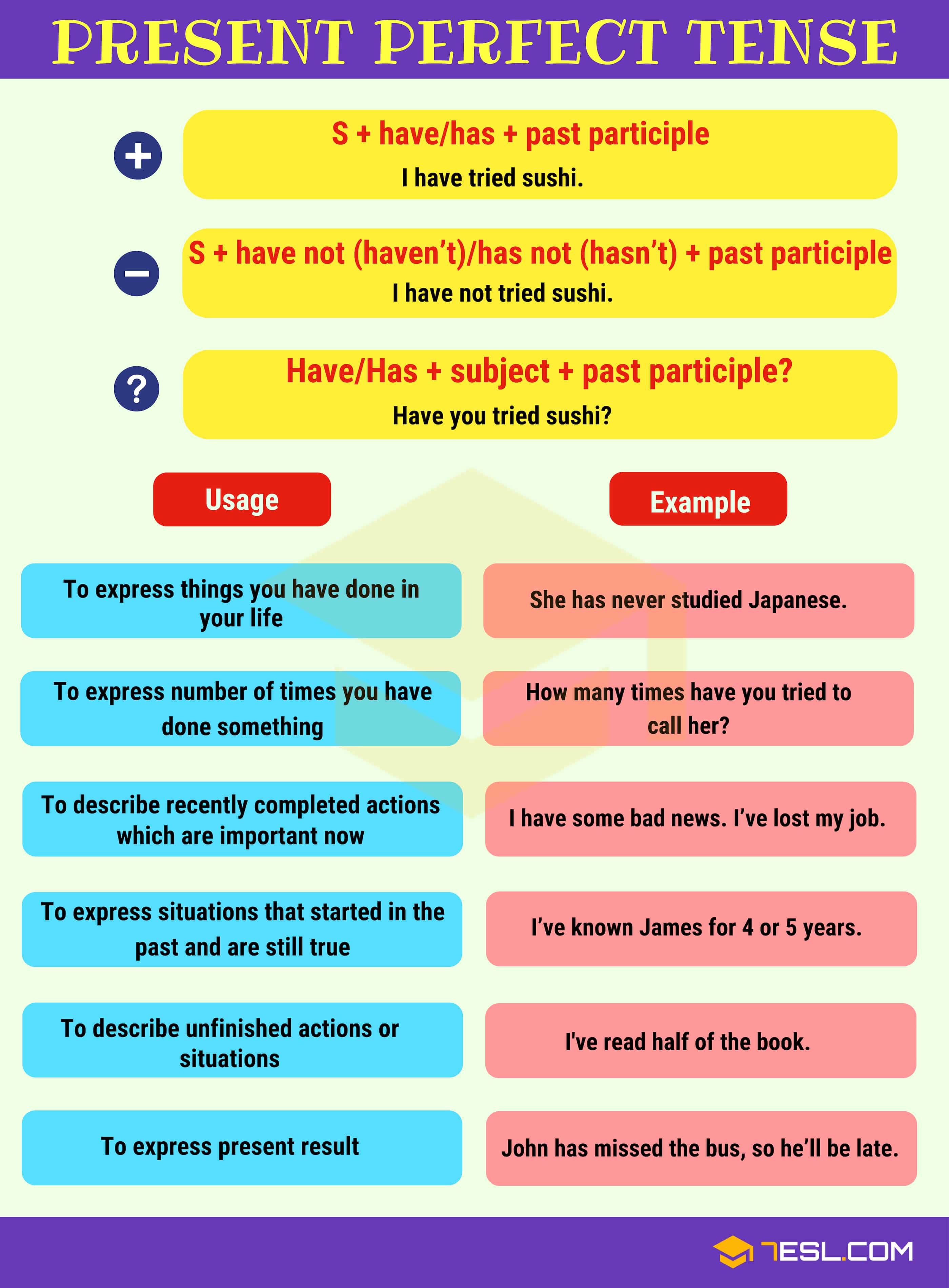

Present Perfect Tense! This reference explains what the present perfect tense is and how you can use it to speak more clearly about actions and their timing. It covers the structure of the tense and provides examples to help you understand it better. You will also learn about the usage of the present perfect tense, including time adverbs, with useful grammar rules, example sentences.

The Present Perfect Tense is used to describe actions that have happened at an unspecified time before now.
It connects the past with the present.
Common uses include:
Keywords
Certain words often signal the present perfect tense:
The present perfect tense is used to talk about actions that happened at an unspecified time before now. It is also used to describe actions that have an impact on the present moment.
In affirmative sentences, the present perfect tense is formed using the auxiliary verb “have” (or “has” for he, she, it) followed by the past participle of the main verb.
Negative sentences in the present perfect tense use the auxiliary verb “have” or “has” followed by “not” and the past participle of the main verb.
Interrogative sentences in the present perfect tense start with the auxiliary verb “have” or “has” followed by the subject and the past participle of the main verb.
These structures help in correctly forming sentences in the present perfect tense and convey actions related to the present time.
The present perfect tense connects past actions or events with the present. It is often used to describe actions that were completed in the past but still impact the present.
This tense shows actions finished at some point before now. For example, “She has finished her homework.” The exact time isn’t given, but we know it’s completed. This is helpful when talking about achievements or changes that are important in the present.
The present perfect tense highlights actions that have results or consequences in the present. “He has lost his keys” means he can’t find them now. This usage bridges the past and the present, emphasizing how a past event affects the current situation.
When talking about experiences someone has had in their life up to now, the present perfect tense applies. “They have traveled to Japan” means at some point in their lives, they visited Japan. It doesn’t specify when, just that it has happened. This aspect focuses on the fact, not the timing.
The present perfect tense refers to actions that occurred at an unknown time before now. It uses terms like “ever” or “never.” “I have never eaten sushi” means at all times up to now, sushi hasn’t been eaten by the speaker. This helps in discussing experiences without needing specific time details.
Time expressions help understand when an action happened. In the present perfect tense, words like “already,” “yet,” “for,” “since,” “just,” “ever,” and “never” are used to give clear time context.
Already is used in positive sentences to show that something has happened sooner than expected. For example, “She has already finished her homework.” It indicates that the action is completed.
Yet is used in negative sentences and questions to talk about something that hasn’t happened but is expected to. For instance, “Has he finished his homework yet?” and “He has not finished his homework yet.”
For is used to talk about a period of time. For example, “They have lived here for ten years.” It shows the duration of time.
Since points to the starting time of an action. For example, “They have lived here since 2010.” It tells when the action began.
Just is used to indicate a recently completed action. For example, “She has just finished her lunch.” It highlights that the action happened in the very recent past.
Ever is used in questions and negative sentences to refer to any time up to now. For example, “Have you ever visited France?” It asks about any past experience.
Never is used to mean not at any time. For instance, “He has never visited France.” It means not once in the past timeframe.
These expressions help provide clear context and time relationships in present perfect statements.
The Present Perfect Tense and Past Simple Tense have distinct differences, especially when it comes to finished and unfinished actions as well as specific and general time references.
The Present Perfect Tense often deals with actions that started in the past and continue into the present or have relevance now. For example, “She has lived in Madrid for three years” means she still lives there.
In contrast, the Past Simple Tense describes actions that are completely finished. For example, “She lived in Madrid for three years” means she no longer lives there. This difference is key when choosing which tense to use.
Another difference is in time references. The Present Perfect Tense is used for actions that happened at an unspecified time before now, like “They have traveled to Japan.” The exact time isn’t important.
The Past Simple Tense, on the other hand, is used for actions that happened at a specific time in the past. For example, “They traveled to Japan last year.” This gives the listener a clear time frame for when the event occurred.
These distinctions help in clearly communicating when and how actions occurred.
To practice the present perfect tense, it’s helpful to work through exercises. Here are some activities:
Complete the sentences with the correct form of the verb.
Transform these sentences into the present perfect tense.
Answer the questions using the present perfect tense.
Decide whether the sentences are correct.
Connect the phrases to form correct sentences.
Respond to questions using the present perfect tense.
Learn all (12) tenses in English with useful grammar rules, examples and ESL worksheets.
An experienced English grammar teacher since 2015, with a dedication to helping students improve their language skills.
Latest posts by Grammargeek (see all)